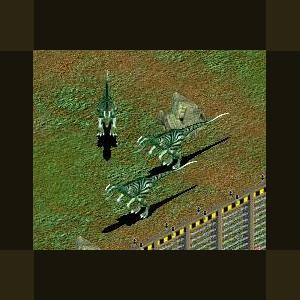About This File
Dilophosaurus
Dilophosaurus was a theropod dinosaur from the Early Jurassic Period. The name is pronounced ("dy-LOH-fo-sawr-us") meaning 'two-crested lizard', because it had two crests (Greek di meaning 'two', lophos meaning 'crest' and sauros meaning 'lizard')
Dilophosaurus measured around six meters (20 ft) long and may have weighed half a ton.
The most distinctive characteristic of Dilophosaurus is the pair of rounded crests on its skull, possibly used for display. Studies by Robert Gay show no indication that sexual dimorphism was present in the skeleton of Dilophosaurus, but says nothing about crest variation. The teeth of Dilophosaurus are long, but have a fairly small base and expand basally. Another skull feature was a notch behind the first row of teeth, giving Dilophosaurus an almost crocodile-like appearance, similar to the putatively piscivorous spinosaurid dinosaurs. This "notch" existed by virtue of a weak connection between the premaxillary and maxillary bones of the skull. This conformation led to the early hypothesis that Dilophosaurus scavenged off dead carcasses, with the front teeth being too weak to bring down and hold large prey.
The first Dilophosaurus specimens were discovered by Sam Welles in the summer of 1942. The specimen was brought back to Berkeley for cleaning and mounting, where it was given the name Megalosaurus wetherilli. Returning to the same formation a decade later to determine from which time period the bones dated, Welles found a new specimen not far from the location of the previous discovery. The specimens were later renamed Dilophosaurus, based on the double crest clearly visible in the new skeleton.
There is another species of Dilophosaurus (D. sinensis), which may or may not belong to this genus. It is possibly closer to the bizarre Antarctic theropod Cryolophosaurus, based on the fact that the anterior end of the jugal does not participate in the internal antorbital fenestra and that the maxillary tooth row is completely in front of the orbit and ends anterior to the vertical strut of the lacrimal. This species was recovered from the Yunnan Province of China in 1987, with the prosauropod Yunnanosaurus and later described and named in 1993 by Shaojin Hu.
A third species, D. breedorum, was coined by Samuel Welles through Welles and Pickering (1999). This species was based upon crested specimen UCMP 77270. Welles' original material lacked well-preserved crests, and he suggested that the crested specimens pertained to a different species. He was unable to complete a manuscript describing this during his lifetime, and the name eventually came out in a private publication distributed by Pickering. This species has not been accepted as valid in other reviews of the genus.
Dilophosaurus was prominently featured both in the 1993 movie Jurassic Park and in the original novel by Michael Crichton. In the film version, Dilophosaurus has a retractable neck frill around its neck (much like a frill-necked lizard), and spits blinding poison, aiming for the eyes to blind and paralyze its prey (much like a spitting cobra). There is no evidence to support either the frill or the venom spitting, which was acknowledged by Crichton as creative license.In the film, Steven Spielberg also reduced the size of Dilophosaurus to 3 feet (0.91 m) tall and 5 feet (1.5 m) long, much smaller than it was in reality. Jurassic Park merchandise, including toys and video games (such as Jurassic Park: Operation Genesis and the arcade games The Lost World: Jurassic Park and Jurassic Park III), often include Dilophosaurus.
Despite its inaccuracies, the Jurassic Park Dilophosaurus has been taken up by others. Several other video games, such as ParaWorld and Jurassic Wars, and Ice Age: Dawn of the Dinosaurs feature Dilophosaurus modeled after the representations in Jurassic Park, and The Whitest Kids U'Know sketch "Dinosaur Rap", a music video for Trevor Moore's "Gettin' High With Dinosaurs" features a Dilophosaurus, complete with a short frill. One video game, 2008's Turok, features Dilophosaurus based more closely on real fossils and displays their correct size. Dilophosaurus was also featured in the documentary When Dinosaurs Roamed America, killing an Anchisaurus and scaring off a pack of Syntarsus (now known as Megapnosaurus).



Recommended Comments
There are no comments to display.
Create an account or sign in to comment
You need to be a member in order to leave a comment
Create an account
Sign up for a new account in our community. It's easy!
Register a new accountSign in
Already have an account? Sign in here.
Sign In Now